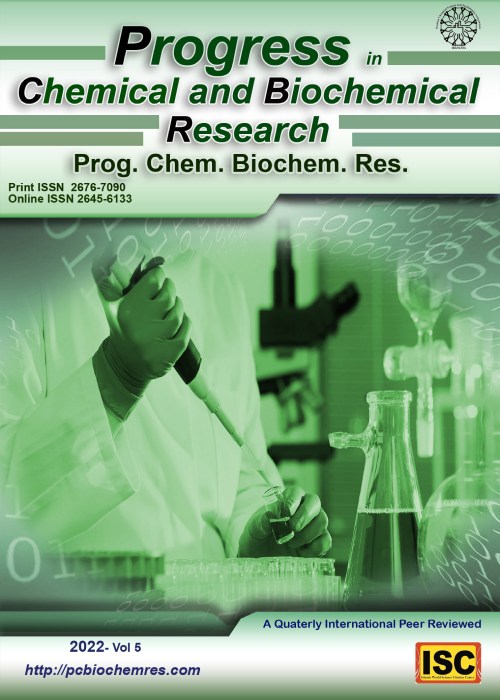فهرست مطالب
Progress in Chemical and Biochemical Research
Volume:1 Issue: 1, Oct 2019
- تاریخ انتشار: 1397/07/09
- تعداد عناوین: 6
-
Pages 1-10A new enzymeless glucose sensor has been fabricated and its electrocatalytic oxidation has been investigated in alkaline medium directly on the Pt Electrode modified by Activated carbon nanotubes @ graphene oxide/ nickel hydroxide-Nafion hybrid composite (PtACNT@GONHNPsNf). Under the optimized condition, the calibration curve is linear in the concentration range of 5-1100 µM using cyclic voltammetric method. The detection limit and sensitivity are 0.75 µM and 40 nA, respectively. The glucose sensor can be renewed easily in a reproducible manner by a simple polishing step and it has a long operational lifetime and short response time t90% < 1 s. In addition, the fabrication of Pt with nafion and nickel hydroxide powder was employed to eliminate the interference of ascorbic acid during the catalytic oxidation of glucose. The biosensor was used for determination of glucose in human blood serum and the oxidant with satisfactory results.Keywords: Ni(OH)2 nanoparticles, Activated Carbon nanotubes, Nafion, Glucose sensor, graphene oxide
-
Pages 11-18
Cyclic Voltammetric studies of calcium acetate salt [Ca(CH3COO)2] in absence or presence of Methylene blue (MB) were performed to predict and analyze the behavior of complexation between the ligand and metal ion in aqueous solution. From these studies, the values of solvation and kinetic parameters [Ep (peak potential), Ip(peak current), ΔEp (peak potential difference), E½ (half wave potential), D(Diffusion coefficient), Ks (electron transfer rate constant), Г(surface coverage) and Qa (quantity of electricity)] were evaluated. In addition, the effect of different concentration and a scan rate of above the calculated quantities were studied. In case of presence MB, the stability constants and Gibbs free energies were performed.
Keywords: Cyclic Voltammetry, Gold Electrode, Calcium acetate, Methylene blue, redox reaction, Solvation parameters -
Pages 19-28The molar solubility for 2-amino-4,5-dimethylthiophene-3-carboxamide (ADTC) in pure ethanol and mixed ethanol (EtOH)- water solvents were measured at five different temperatures, 293.15, 298.15, 303.15, 308.15, and 313.15 K in the used mixed solvents, the solubility were increase by increase in the mole fraction of ethanol in the mixtures and increase of temperature due to more salvation parameters. All the solvation and thermodynamic parameters for ADTC in mixed EtOH+ H2O solvents were evaluated like solubility products, Gibbs free energies, enthalpies and entropies of solvation and discussed. Theoretical calculations for (ADTC) were done quantum mechanically by using Gaussian on set of calculations in ethanol for evaluating the different thermodynamic parameters.Keywords: Thermodynamic, Theoretical solvation, Dimethylthiophene-caboxamide
-
Pages 29-39Peptic ulcer disease is one of the most prevalent gastrointestinal disorders causing tremendous human suffering worldwide. The present study was designed to evaluate the antiulcerogenic activity of the methanol and solvent stem bark fractions (hexane, ethyl acetate and butanol) and elucidate their possible antiulcerogenic mechanisms. The antiulcerogenic mechanisms were investigated by estimation of Superoxide dismutase (SOD), Glutathione (GSH), Catalase (CAT), Vitamins A, C and E, Malondialdehyde (MDA) and involvement of KATp channel. Pretreatment with the methanol extract and solvent fractions produce significant reductions in ulcer index in a dose dependent manner. Ethylacetate fraction (EtyAc) showed the highest antiulcer activity. Elevated MDA and decreased levels of SOD, GSH, CAT, Vitamin A, C and E observed in ulcer control groups were significantly decreased and increased respectively in the EtyAc fraction treated groups. Antiulcer activity of the EtyAc fraction was blocked upon coadministration with glibenclamide; a KATp channel blocker. The stem bark extract of Lannea acida possess antiulcerogenic activity and the mechanisms seems to involve antioxidant activity and KATp channel opening.Keywords: Antiulcerogenic, Lannea acida, Mechanism, Ethanol, Gastric, Mucosal, Albino Rats
-
Pages 40-49
Reduced graphene oxide (rGO) is synthesized using strong oxidizing agents with the help of chemical reduction method. Structural and physiochemical properties of the prepared sample are studied by ultraviolet-visible spectroscopy (UV-Vis), Fourier transform infrared spectroscopy (FTIR), X-ray powder diffraction (XRD) and scanning electron microscopy (SEM). UV-Vis spectra of GO exhibit maximum absorption peak attributable to restoration of sp 2carbon. Electrochemical study performed for bare and rGO modified glassy carbon electrode. Electrochemical sensing of Dopamine (DA) and Uric Acid (UA) was examined by cyclic voltammetry (CV), electrochemical impedance spectroscopy (EIS) and square wave voltammetry (SWV) were conducted in phosphate buffer solution (PBS) at pH = 7.0 done for both simultaneous and individual determination of DA and UA in the range of 500nM – 1mM exhibit a wide linear range of detection and having low limit of detection (LOD) of 0.67µM for DA, and 0.69µM for UA estimated for simultaneous determination and in individual determination it was found to be 0.51µM and 0.42µM for DA and UA respectively. Additionally, the modified electrode exhibits good reproducibility, selectivity, sensitivity and stability. The proposed sensor could be applied for the determination of DA and UA in real samples.
Keywords: Graphene oxide (GO), Hummer’s method, Cyclic Voltammetry, Electrochemical sensor, Dopamine, Uric Acid -
Pages 50-59Synthesis and Characterization of Inorganic–organic hybrid Tungsten oxide-ethylenediamine (WOx–EDA) nanowires have been carried out by a simple, low-cost and high-yield solvo-thermal method. The WOx–EDA nanowire adsorbent was characterized using, Fourier-transform infrared (FT-IR) spectroscopy, scanning electron microscopy (SEM), transmission electron microscopy (TEM) and Energy Dispersive X-ray spectroscopy (EDX). Adsorptive potential of the hybrid for aqueous phase copper and lead removal was investigated using batch adsorption process. The equilibrium data were subjected to various isotherm models. The Langmuir model shows high applicability (R2 of 0.921) for lead uptake. Other R2 values include 0.882 (for Freundlich model), 0.947 (Temkin) and 0.972 (Dubinin- Radushkevich). Similarly, adsorption experimental runs for Cu uptake gave correlation coefficient (R2) values of 0.972, 0.584, 0.906 and 0.899 for the Langmuir, Freundlich, Temkin and Dubinin- Radushkevich isotherm models respectively. Overall, Tungsten oxide ethylenediamine adsorbent proved its potential candidature for the chelating treatment of Pb and Cu poisoning as well as purifications of water containing such metals. Sorptive chelation of metals by inorganic functionalized organic WOx–EDA nanowires: adsorbent characterization and isotherm studiesKeywords: Adsorption, Tungsten oxide-ethylenediamine, Metals, copper, Lead, Isotherm, Nanotubes, Nanobelts


